9 Essential Home Office Design Tips
Are you planning to add a home office to your home? Whether your home office design will be located in an annex, a small bedroom, or just the corner of a room, there are a few essentials you will want to consider when creating a productive workspace at home.
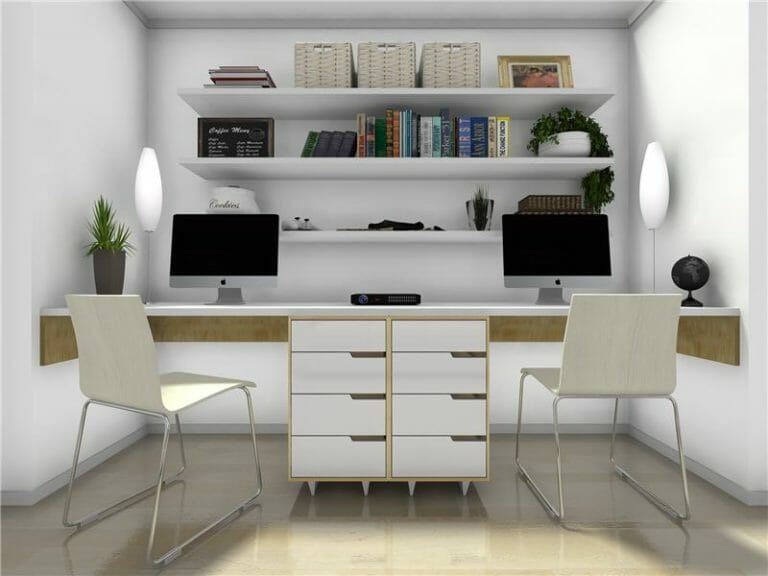
If you spend the full work week there or even just a few hours, it’s important that your home office be a comfortable and inviting place to spend time and to get your work done efficiently.
Read on for our 9 essential tips for creating a beautiful and practical home office design:
1. Location Is Key
Home offices come in many different shapes and sizes. It can be in a separate room, a quiet corner, or even in your kitchen. The key to selecting the right place for your home office is to think about where and when you do your work.
If you are a busy mom, a kitchen desk area may be the ideal place for your central command post. However, if you’re a professional, you’ll want to select a space that’s away from the daily flow and distractions of your household.
2. Allow Enough Space
Make sure you allow enough space to work comfortably. Ask yourself if you will be able to move easily from side to side, stand up and sit back from your desk. While this may seem like a no-brainer, it’s easy to underestimate how much space you need.
To avoid this, use the same key measurements professional designers use to lay out a workstation – allow at least 60” (150cm) in width and 84” (210cm) in depth.
Need more inspiration?
3. Selecting a Desk and Chair
Choosing the right desk and chair for your home office is essential. Select a desk that is wide enough for your computer and anything else necessary to do your work. This could be an in-tray, reference materials, or space to take notes. Ideally, your desk should 48” (120cm) wide minimum.
However, if all you ever need is a laptop you can get away with less. Most people find 60” (150cm) wide or larger to be the most comfortable. While an adjustable-height desk is ideal it’s not always practical in a home office setting.
Choose a desk that is not too high – 28”-30” (70-75cm) is an acceptable range. Invest in a good-quality chair that is comfortable and adjustable if possible.
Your neck and back will thank you.

4. Storage and Shelving
Storage is often overlooked when designing a home office and can really affect your productivity. Make sure to include enough shelving, filing cabinets or cupboards for your storage needs. Consider your workflow – what comes in, where will it stay while being worked on, and where does it go when complete?
Place your inbox on or next to your desk. Keep your current work within arm’s reach. Locate your filing system nearby. Don’t forget reference materials – if you use manuals, catalogs, or reference books, locate a shelf near your desk to keep them close at hand.
"One essential tip I always recommend for a home office is maintaining a clutter-free desk. Believe it or not, a clean desk does more than just make your workspace look good; it helps clear your mind, too. A clutter-free environment enhances your focus and allows you to zero in on your tasks without the distractions of stray papers, sticky notes, or tangled cables.
To accomplish this, I suggest utilizing wall organization solutions like shelves, pegboards, or pin boards. They not only help keep your desk clear but also keep essential items within arm's reach. It's a smart way to maximize your workspace without sacrificing functionality."
Zakhar Ivanisov, Soul & Lane
5. A Place to Meet
Will you have clients or customers visit during the day? If you have room to have a small meeting area, that is ideal.
If not, plan for some additional seating in your home office design to allow for sit-down meetings. This can be as simple as 1-2 comfortable chairs, which are easy to pull up to your desk.

6. Natural Light and View
Good lighting is critical for any home office space. Choose a location with some natural light and a view if possible. Position your desk to face the windows or in a location where your computer screen will not be affected.
Translucent window shades or blinds can help reduce any glare without darkening your room. You can enhance natural light by including a mirror and by keeping most of your walls a light color.
An overhead ceiling light will provide good general lighting. A pair of open-top floor lamps placed in the corners of your room will do the same. Include a desk light to provide shadow-free task lighting and extra light in the evenings. Add some full spectrum daylight bulbs in your light fixtures for an extra boost.
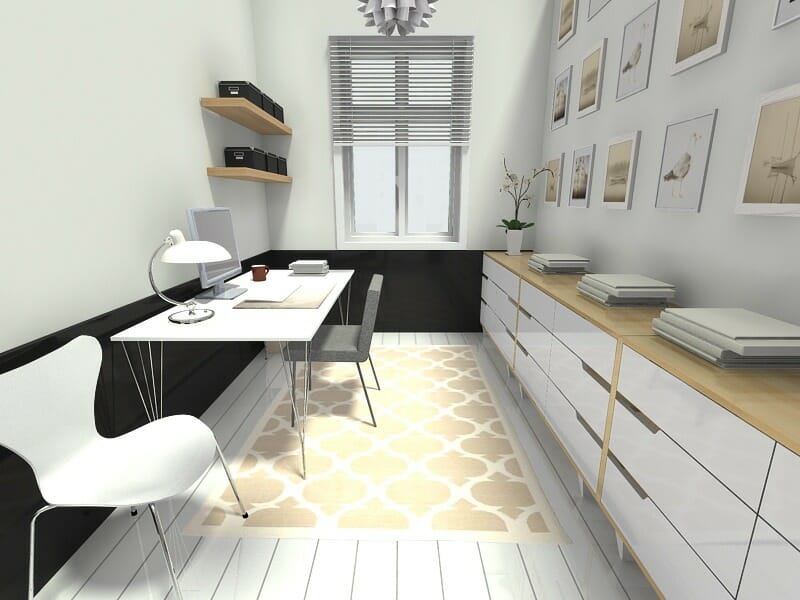
No view? Position your desk to face the door instead or place a pleasing piece of artwork or an inspirational pinboard above your desk. Either, will give your eyes a rest and something to focus on when you look up from your work.
7. Tame Your Technology
Nothing makes a home office look or feel more cluttered than wires hanging from your desk and running everywhere. Hide your desk cords and take control of your technology with these simple tips:
- Add a wireless router – you’ll reduce your wires by half
- Invest in both a wireless printer and a wireless mouse
- Add a grommet in your desktop to lead any wires from your desk down below
- Attach any visible wires to the underside of your desk or down along a desk leg
- Gather loose wires along the floor together with a simple cord tamer
8. Accessorize and Personalize
Don’t sacrifice on style! The great part about working from home is that YOU can decide how you want your home office to look and feel. Match your home office with the design and style of your home.
Think about what inspires you. It could be a favorite piece of artwork, a collection of objects, or an invigorating paint color. Include these personal touches when you plan your home office design. It will brighten up your day and make you feel… at home.
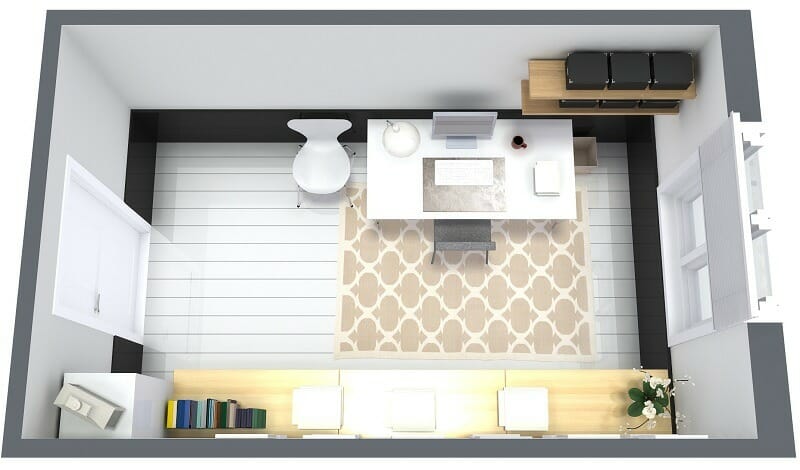
9. Make a Floor Plan
An office floor plan is an excellent tool to organize your thoughts and to make sure you’ve covered all your bases. You can create a floor plan easily online with the RoomSketcher App.
Create furniture layouts and floor plans. Try different pieces of furniture and determine which location in your home will work best. Design a complete home office design before you start shopping.
When you’re ready for more powerful 3D features and to generate high-quality 2D and 3D Floor Plans, simply upgrade – it’s that easy!
Don't forget to share this post!
Recommended Reads
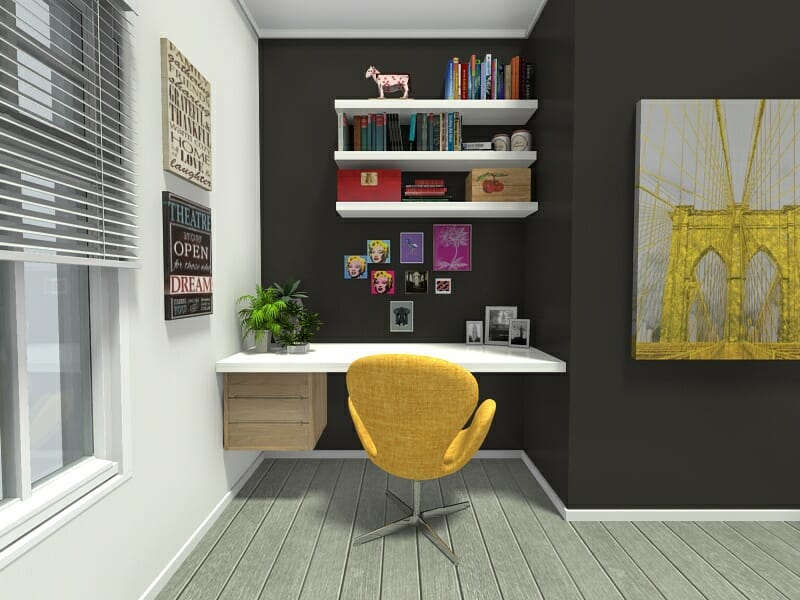
9 Tips for Creating the Perfect Built-in Home Office Desk
Looking for DIY home office ideas? Try painting a desk. Paint is a great way to give an old wooden desk a fresh updated look with modern appeal.
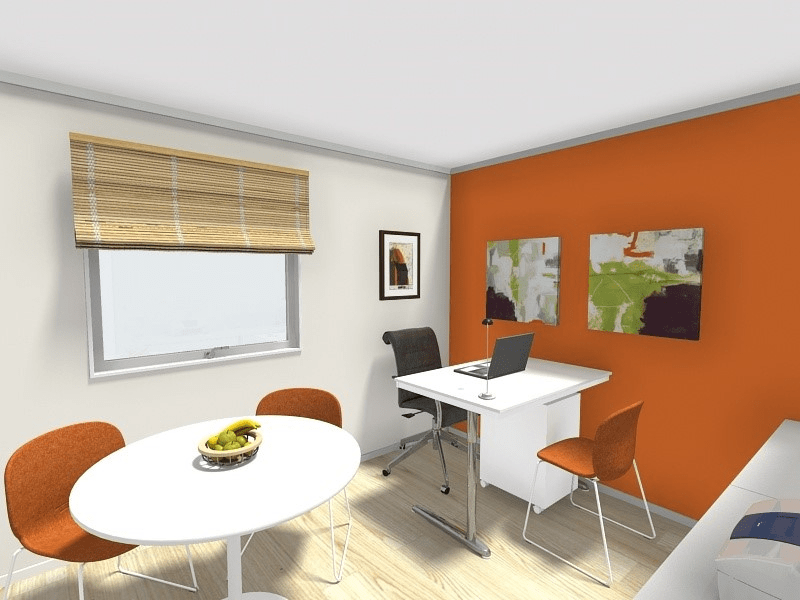
5 Great Ideas for Small Office Floor Plans
Your office does not have to be big to be a perfect place in which to work. If you arrange the items in the room wisely, you can maximize the space you have.

Design Your Ideal Home Office
A well-designed, functional, and beautiful home office can make your working hours more efficient and more enjoyable.